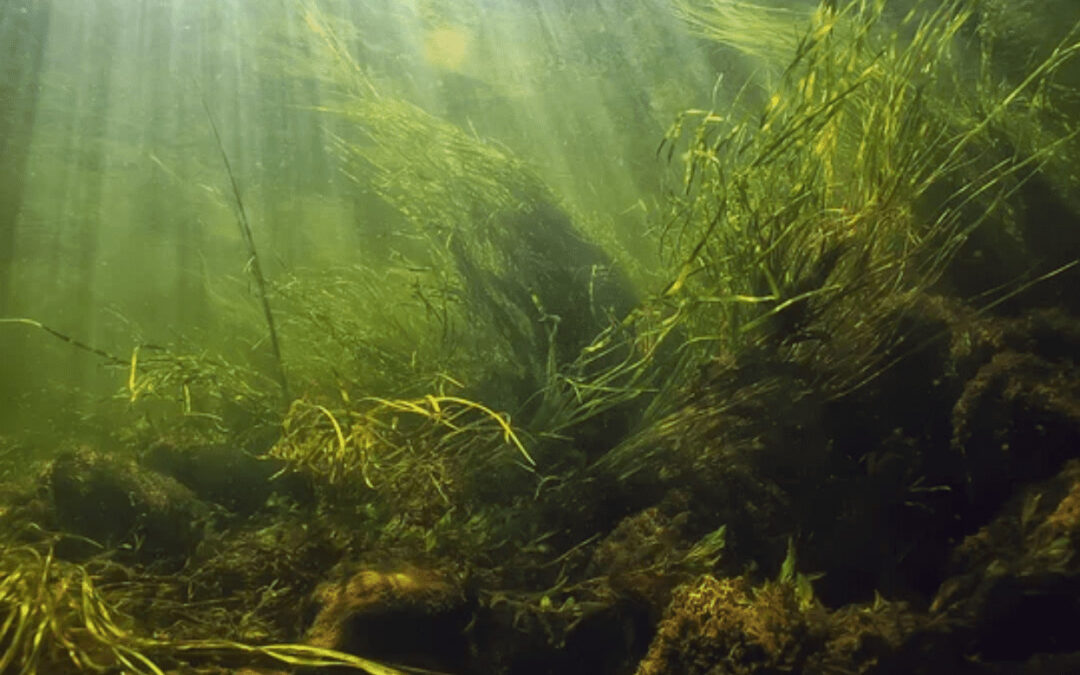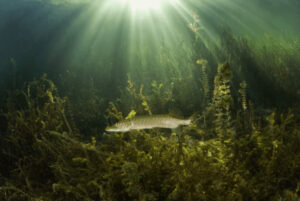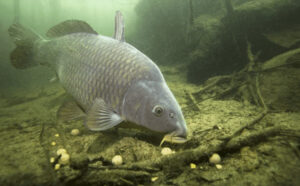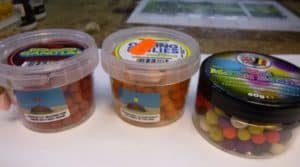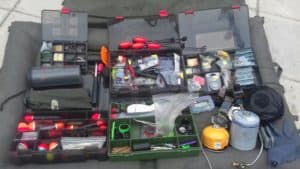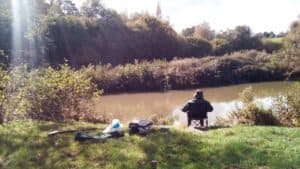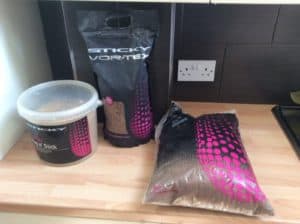Feature finding when carp fishing is an art form, and if you want to truly succeed you must understand how to utilise the natural structures of the carp lake or body of water.
In this article, we will explore the tips and tricks for becoming a master of carp fishing.
From reading the water and using the right bait, to understanding the behaviour of carp and their natural habitats, this post will provide a comprehensive guide to carp fishing.
How Do You Feature Find When Carp Fishing?
When carp fishing, one of the most important things a successful angler will do is to read the water.
By understanding the depth, bottom composition, and other features of the lake or river you are fishing in, you can more accurately predict where carp may be hiding.
Additionally, it is important to note that carp prefer different habitats at certain times of the year, so be sure to adjust your techniques accordingly.
Once you have read the water and determined the possible carp hideaways, you can start looking for other features that may make them easier to catch.
Look for areas with sunken trees or weeds, as these provide great hiding spots for carp.
If there are any sand bars or other areas that seem to be attracting fish, these are also worth targeting.
Additionally, consider any rocks or fallen trees in the water, as carp love to hide behind these structures during feeding times.
To find these areas, you need two key bits of kit. A Deeper castable fish finder, and a marker rod.
Why Natural Features are Good for Carp Fishing
Carp fishing often involves using natural features as a way to locate fish.
Submerged logs, undercut banks, and vegetation are great places to target carp, but gravel bars can be just as effective.
Gravel bars provide the perfect hiding spots for carp, as they are areas with loose gravel or stone.
When carp hide in these areas it makes it easier for anglers to identify them and land a big catch.
Carp fishing in rivers and lakes can be an exciting and rewarding sport. One way to enhance the experience is to take advantage of man-made structures such as boat docks, bridges, and gravel bars for cover for the fish.
These structures can be beneficial by giving the carp a place to hide from predators as well as providing them with food sources like algae and other aquatic organisms that grow around these structures.
Additionally, some of these areas may have deeper water levels which are ideal for carp looking for opportunities to feed or rest.
By recognising these man-made structures while out on the water, anglers can increase their chances of catching this elusive fish species.
Also, when looking for areas to fish, make sure to look around the margins of the lake where fallen trees and drop-offs are located.
These locations typically hold a lot of carp that are ready to be caught by you! So make sure to scout out these spots and you’ll have a higher chance of catching that big carp you’ve been trying for!
The Advantages of Using Natural Features for Carp Fishing
Carp fishing often involves seeking out natural structures such as sunken trees or bushes.
To maximize your chances when carp fishing, it is beneficial to investigate any natural structures present in the areas that you visit and take advantage of the environment that they can offer.
This method of fishing is highly effective as carp are usually found on the margins of lakes and rivers, meaning they can easily be targeted.
By focusing on these margins, anglers have a higher chance of catching carp alongside their other aquatic prizes.
By using natural structures, like a silty area, you can increase your chance of catching carp as these are areas that hold large quantities of natural food.
Understanding these nuances of carp fishing can give you an edge when it comes to being successful out on the water.
Finding Features – Above the Surface
Islands
In spite of the fact that islands are often the most visible features of a lake, they are also frequent patrol routes for carp that are often frequented.
The margins of a lake are often a natural habitat for fish, and the islands are no different. The steep banks of a river offer perfect shelter for carp and provide natural areas where food can settle, just like the margins do.
The advantage of islands is that there are some areas that can be inaccessible for casting hook bait and become natural safe havens for carp in the form of low-hanging tree branches.
There are some areas of the island that are difficult to cast to, however, laying a trap close to the island edge and scattering a large amount of bait around will help to stop the carp from patrolling the margins of the island or draw them out of their protected areas.
When I scatter bait over a greater area rather than tightly baiting it, I find that fish will find food easier to find. This is especially true on lakes with a lot of fishing pressure, where carp may not be as suspicious of this approach as they might be of tighter baited areas, which can cause them to associate this approach with danger.
Weed beds, Reed Beds, Lily Pads, and Overhanging Trees
Identifying natural structures in the water can be a great way to target carp while fishing.
Look out for weed beds, reed beds, lily pads, overhanging trees, and drop-offs which are likely spots where carp will congregate looking for natural food.
Areas of Canadian pond weed, silk weed, and other types of weed hold lots of carp due to the amount of natural bait it holds. Bright baits work really well near weed.
Take time to look for these features when scouting for an ideal spot to fish and you’ll maximise your chances of successfully catching carp.
Carp fishing can be a tricky endeavor, and increasing one’s chances of success is always an appreciated bonus.
Boilies are best used near weed beds, maggots near reed beds, and for gravel bars, worms are generally the most successful option.
Knowing which bait to use for each type of structure can help you make the most out of your carp fishing experience.
Identifying Key Features for the Best Results
When searching for obvious features, remember to look for areas with margins or points in the water. The margin may be a simple feature but, these areas hold lots of carp.
Carp are attracted to such places as they can provide natural food, shelter, and a safe space away from predators.
Therefore it’s important to search the banks of rivers, lakes, and waterways for these types of margins or points as these are hotspots that can mean an increase in catch rate when targeting carp.
Fishing in the margins is a popular technique when fishing for carp, particularly near snags.
Heavy snags, such as tree branches underwater almost always contain carp. Snag fishing is very effective when done correctly.
Areas, where there are weed beds, overhanging trees, and submerged logs, provide places for carp to hide and also provide them with food sources, making them an ideal spot for catching them.
It helps to know the local environment and to identify spots where these types of hiding spots and food sources exist. With the right knowledge, anglers can improve their chances of landing a carp by honing in on these areas.
All in all, carp fishing is an endlessly rewarding experience for novice and experienced anglers alike.
Knowing which structures are most important when trying to spot carp, such as reeds and lilies, can provide great opportunities for angling.
These elongated shallow areas help draw large numbers of fish to islands near the shore, making them prime spots for fishing.
Finding Features – Underwater
Gravel Bars, Drop-offs, Sunken Trees, and Silt Patches
When it comes to carp fishing, understanding the features of the water is key.
Most carp will be aware of their environment, so anglers need to make sure they identify the features that make up the location such as drop-offs. These areas are good sources of food.
Knowing where these drop-offs are in relation to other features such as weed beds and areas with certain depths can help you understand where to locate your baits and how carp may use these features for their own benefit.
This knowledge gets even more detailed when looking at seasonal temperatures, which can all prove beneficial when trying to successfully catch a carp.
When carp fishing, selecting the right baiting strategy can be critical for success.
By fishing within gravel spots finding a gravel patch, for example, you are more likely to attract carp due to the higher levels of food and oxygen located in these areas, particularly in gravel pits.
Additionally, making sure your bait is tailored specifically to the type of fish you are targetting will increase your chances of catching a carp.
Utilising these techniques will enhance your prospect of snatching a big one!
Again, utilising different techniques such as stalking, margin fishing, and long-range casting can help maximise your success when carp fishing, especially if these strategies are used to target drop-offs and other likely spots.
Becoming familiar with the various methods of carp fishing will allow anglers to be ready for anything and increase their chance of catching these fish.
How to Use a Marker Float to Feature Find When Carp Fishing?
Using a marker rod and marker float is one of the most popular techniques when it comes to carp fishing.
This method helps you locate specific areas in a lake or river that may hold carp, as well as potential feeding spots.
The marker float is simply a buoyant device with an attached line and weight that is cast into the water and then reeled in.
As the weight moves across the lakebed, it will provide you with feedback through the line and marker rod on what type of lake bed the weight is moving across.
You will get positive feedback from gravel spots, weed, and silt pockets. Your weight will tend to get stuck in Canadian pond weed.
You can then use this information to make informed decisions about your bait and approach when targeting these fish.
Avoid using standard carp rods for feature finding, marker rods will give you more accurate feedback.
Using a Deeper Fish Finder to Locate Underwater Features
Using a Deeper castable fish finder is a good way to locate underwater features, but you need to use a marker float to confirm what the Deeper is telling you.
For example, the Deeper will not be able to tell you if the lakebed is made up of gravel or silt, you need to use the marker float to confirm this.
A Deeper castable fish finder is good for the initial investigation, such as finding raised areas of the lake bed, or deeper areas of the lake, but to get a full picture you need to follow up with a marker float.
Bait Placement
Next, when it comes to carp fishing, bait placement is also key.
An important aspect to consider is making sure the bait isn’t too close to the structure as this could scare off the carp.
If you place it too far away from any drop-offs either, then there’s a good chance there won’t be any bites.
Finding the right balance between these two extremes will help increase your chances of catching one of these fish.
Snag Fishing
The term “snag” refers to fallen trees that are submerged in the lake. Most anglers know what a snag looks like, but many don’t realise how important they are to successful fishing. A snag can hold lots of carp as they use snags as safe havens. Here are three tips to make the most of snags when carp fishing.
1. Know Your Equipment
You might think that all you need to do is cast your rig over to the snags and wait for a bite. But there’s a lot more to it than that. You’ll need to make sure your equipment is up to the task. Use a reel that has a strong clutch, you are going to have to tighten that right up. Use snag ears on your bite alarms so your rod doesn’t get pulled into the water. Also, check your knots. Knots can come undone during snag fishing.
2. Be Careful Where You Cast
When casting, keep an eye on the area around the snags. There may be more branches under the water that you cannot see. You need to cast near to the snags, but not directly into them.
3. Choose Your Rig Wisely
Using a PVA solid bag will give you a good presentation near the snags. It’s likely that there will be a lot of debris near the snags, and a PVA bag will give you the best chance. If you cast a bare rig into the snags, there is a high chance the hook will get caught.
How Can I Increase My Chances of Catching Carp?
Finding features of a lake where carp naturally feed is the way to increase your chances of catching more carp.
Try to identify spots where carp may be hiding in the cover or looking for food.
Pay attention to depths, weeds, sunken trees, and other structures that could offer a safe haven for these fish. Fish love shallow water when the sun is out.
Additionally, use the right bait for the area you are fishing; different types of carp like different baits so it’s important to choose wisely.
Features of a Lake
Carp fishing can be a rewarding and enjoyable activity for many, however, understanding the different types of carp and their behavior is essential for achieving success in carp fishing.
Carp of the same species may have varied responses to baits, so observation and incorporation of local knowledge can help determine which bait is best for each situation.
Furthermore, knowledge about the water margins and any natural cover such as trees that are close by can also increase your chances as these areas tend to be where you will find carp.
All these factors combined require a certain level of angling education and watercraft in order to master carp fishing, but once understood they will greatly improve your chances of catching lots of carp.
Carp fishing is an exciting activity, however, it can be tricky to master. It is important to understand carp behavior in order to ensure a successful catch.
This means having the right bait, tackle, and techniques in your arsenal; various combinations of these factors can provide varied results depending on the situation and location.
Taking the time to understand carp behavior as well as using appropriate methods for each situation can yield maximum success when it comes to carp fishing.
To Conclude
In conclusion, carp fishing is an art form that requires patience, precision, and a deep understanding of the environment you’re fishing in.
Utilising natural structures and understanding the behavior of carp can go a long way in increasing your chance of success as a carp angler. As long as you stay calm and remain observant, you’ll soon be an expert angler in no time.
FAQ
What are the main requirements for successful carp fishing?
The main requirements for successful carp fishing include bait selection, tackle selection, understanding of the behavior of the carp, and knowledge of the environment you’re fishing in.
What kind of techniques should be used when targeting drop-offs?
When targeting drop-offs, techniques such as stalking, margin fishing, and long-range casting can be utilised to increase the chances of catching a carp.
How can local knowledge help with carp fishing?
Utilising local knowledge about the water margins and any natural cover close by (such as trees) can help increase the chances of catching carp. It can also help determine which bait is best for each situation.
Is it important to understand carp behavior when fishing?
Yes, understanding carp behavior is essential for achieving success in carp fishing and increasing your chances of catching lots of these fish. Utilizing appropriate methods for each situation can yield maximum success when it comes to carp fishing.
What are the benefits of carp fishing?
Carp fishing can be a rewarding and enjoyable activity for many, with the potential of catching big fish as a bonus. Fishing also provides an opportunity to stay active and spend time outdoors in nature. Additionally, it can be a great way to bond with family and friends.
What other tips are important for carp fishing?
Staying calm and remaining observant is essential when fishing for carp. Pay attention to the water margins and any natural cover close by, as these are likely spots where carp will congregate.
Related Posts
I have made a lot of mistakes during my fishing sessions and don’t want you to make the same mistakes. I’ve learned the hard way over 20 years of fishing most weekends, testing, tweaking, and testing again and now want to help you excel with your carp fishing.
If you need any help, you can reach me at Fishing Again’s Facebook page
Last Updated on February 2, 2024 by Shane

